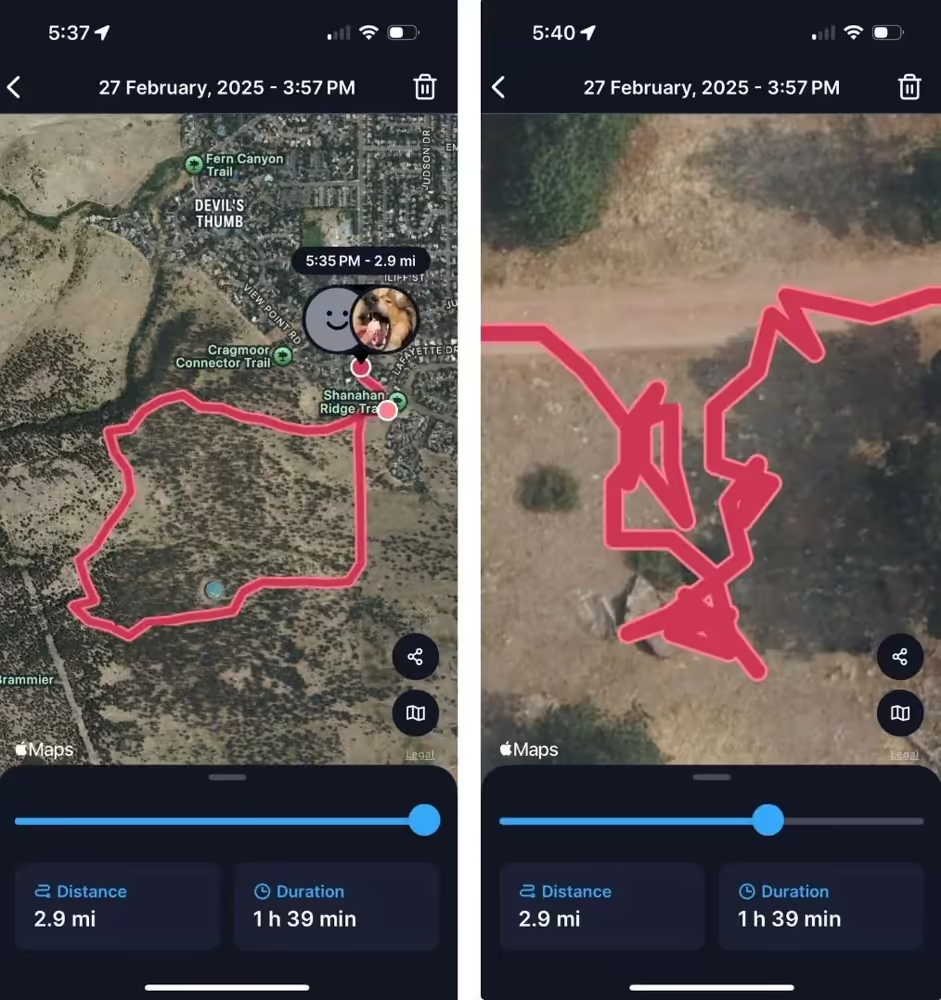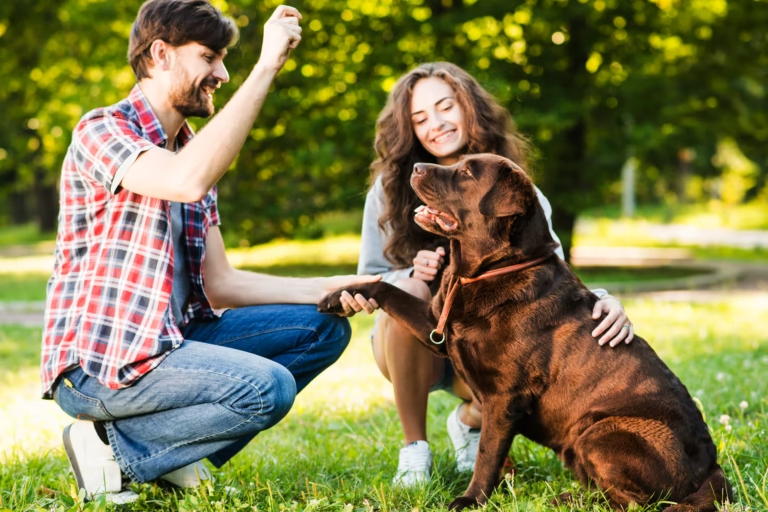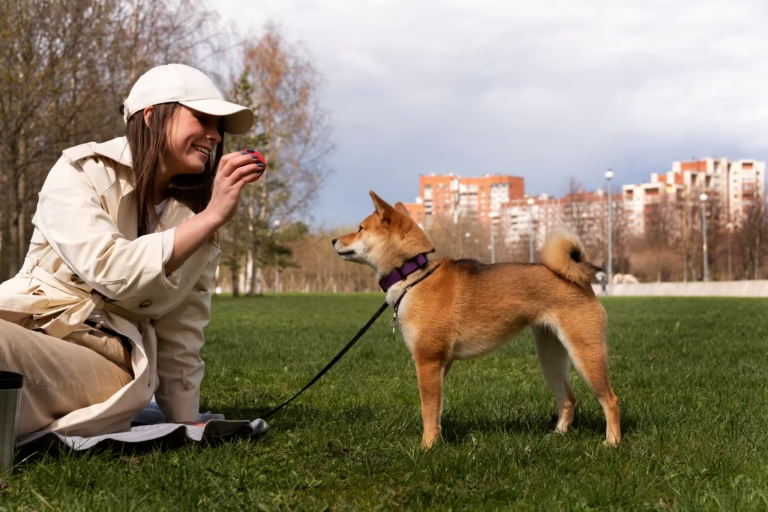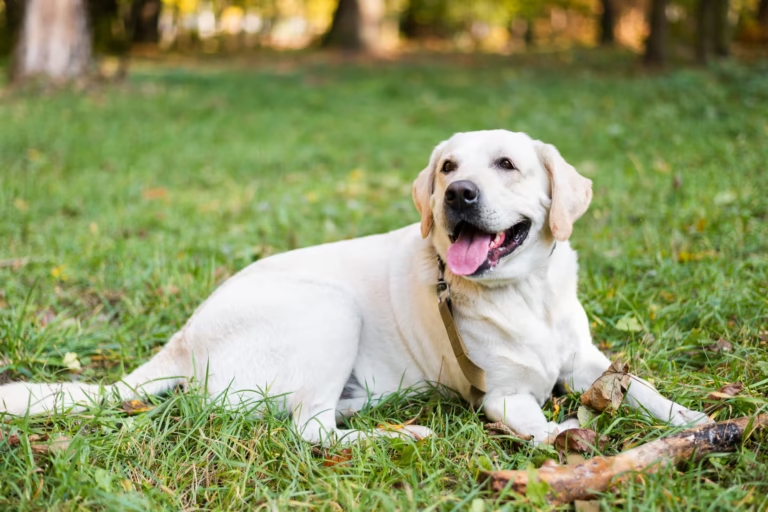
Curious about GPS dog fence collars? Think virtual boundaries you draw on your phone great for large yards with proper training. 21st-century GPS dog fence collars are the answer, without the buried wire. Think of it as a drawing of an invisible fence on a map within your phone that’s essentially how these systems work. Instead of trenching it, a GPS collar and app make a safety zone. Before picking a fence system, it helps to know which trackers support them the GPS dog collars buyer’s guide is a great place to start.
Key takeaways
- Draw virtual yards in an app no wires.
- Best for bigger dogs and open spaces.
- Train the boundary; expect daily charging.
- Geofence alerts are backup, not babysitting.
As long as your dog remains within that virtual perimeter, he’s allowed off the lead; if he veers too near, the collar will vibrate or send out a warning beep. Nothing needed: No wires, no additional collar necessary, just the collar itself (1.34 x 2.09 x 1.26 inch, 2.52 Ounces) and your cell phone and yard places larger than half an acre space. No property is too big! Some models combine containment with full tracking dashboards. Our breakdown of Fi vs Whistle vs Tractive shows how leading brands handle boundaries, alerts, and reliability.
This virtual fence is also portable (bring it on vacation) and infinitely adjustable: You can “draw” multiple borders, form no-go zones (pool, garden, etc.) and even schedule different fences for day versus night.

Wireless GPS fences establish safe zones by satellite signal: sort of an invisible electronic leash. The collar speaks to G.P.S. satellites and the app, in contrast to most ordinary wired fences. When your dog approaches the precipice, the system provides warnings to nudge him away. The system from SpotOn, for example, “sends a series of signals to the collar as your dog walks up to the boundary, so your dog learns to turn around before he gets a paw over the door,” Dr. Gus tells us. Since the collar has GPS, it’s constantly watching your dog’s location (it even uses 128 satellites SpotOn really does not mess around) and can track real time in real time if they make a run for it. Some systems enable you to also pair with phone apps to monitor location or even trigger a remotely activated tone. Not sure a GPS fence is right for your dog? The AirTag vs GPS dog trackers explains the pros and cons of both approaches.
How Wireless Containment Works
In a standard invisible fence, an underground wire sends a radio signal to a dog collar, which pings or zaps the dog when it reaches the perimeter. GPS Fences Invert the model bluetooth GPS Pet Fences depart from this model: instead of a wire in the ground, they use GPS to define a perimeter (a Geo-fence) for the pet. You basically draw the perimeter in an app (or by walking the yard while the collar is on and connected to the phone). Once installed, the collar buzzes or beeps as the dog nears the edge. If the dog fails to respond to these cues, it delivers a brief vibration or tone to snap the dog out of its inaction (some systems also provide warning vibrations or static jolts).
Key points to know
- Setting it up is easy: On most systems you draw a fence on a smartphone. With SpotOn, you are, for example, told to follow it through “a few simple steps,” walking the perimeter, or outlining it on your phone map. Also, using the app, you can set up multiple fences and keep-out zones (around a pool or a garden, for example).
- The boundaries are portable: Because the fence is in the app and relies on G.P.S., you can take it with you. Going on a camping trip? So just pull up a map of the the fence bordering the campsite on your phone. The collar battery will last for 22 hours of containment, according to SpotOn, which would give a day of play after charging.
- Training is necessary: Yes, it’s GPS-based, but your dog still has to learn the new boundary signals. Good news: many systems come with instruction manuals. For example, SpotOn has “easy-to-follow training videos,” to teach the owner to train their dog what the warning sounds mean. Like a wired fence, training sessions with flags and treats will teach your dog where the invisible line is.
- Extras: Some GPS fences come with optional subscriptions. The SpotOn for example, has optional cell plan features like GPS tracking, geofencing alerts (up to every 6 seconds!), low battery warning notices, remote “call the dog” tones, and collar lights. (You’ll still get basic fence containment without the subscription; the extra plan mostly gets you remote tracking and alerts.)
Pros of GPS Dog Fence Collars
- No trenches, no wires, no vinyl fences: The biggest perk is that you don’t have to excavate at all. The hardware you’re using is just your collar and (for the vast majority) your phone. This not only makes it a super easy installation but the system also becomes super portable (handy if you are renting or tend to relocate a lot). It is pleasant to look at, the kind of welcoming, agreeably stylish demarcation that is more pleasurable to the eye than a great ugly fence.
- Flexible borders: Resist the urge to confine your border in a plain circle or yard edge. You can draw many different [[custom|custom Terrain]] shapes and split region s, and you can make temporary fences. Then you can use a bigger one during the day. Seasonal fences exist too, of course, but that will grinch up your dog’s off-season swimming enthusiasm (CaN).
- Possible to big property fan: Wired fences can get costly when you’re looking at many acres. No Limit to GPS Fences. It’s About Signal. Indeed, SpotOn is proud that no property is too big; if you’ve got more ground to cover, go ahead and drop another pin on the map. The system takes care of all of it, whether you have 1 acre or 100.
- Travel and temporary use: Would you like to take your dog on holiday? You don’t have to buy a second invisible fence. Shove your destination into the app, and deploy a brand-new fence. A few owners use these collars as makeshift fencing for vacation homes or while they’re traveling by RV.
- Additional safety features (with subscriptions): In addition to containing your dog, there are other safety features that come standard on many of the GPS collars: flight geofencing, which sends your phone an alert as soon as the dog is outside the allowable flight space, 24/7 tracking, an LED light on the collar, and one-button audio that can help bring your dog back. Those features offer a small dose of peace of mind in case your dog scoots off, and many paired models can also be remotely activated using your phone.
Limitations and Considerations
- Requires an open, clear location: Obstructions can spoil GPS accuracy. This signal may rebound or be absorbed by metal roofs, dense tree coverage, or tall buildings. This is also a problem in heavily wooded or urban areas: the woods can block satellites and provide crumby location, but some collars have a special “forest mode” to compensate for this. “In practice, most experts would recommend using a GPS fence only in relatively open yards,” Korosec said — big lawns, farms and the like, not bitty urban backyards.
- Yard size and dog size limitations: Nearly every GPS fence brand will state that they only endorse this tech for larger areas and/or larger dogs. For a pre-wireless GPS fence to even be the best choice, you must have (1) at least an acre to work with, (2) a minimal amount of trees and stumbling blocks in your desired containment area, and (3) a dog who weighs at least five pounds. SpotOn’s system also comes in collars sized up to 10–26 inches and advises to wait until a puppy has “filled out” (usually around 15+ lbs). In short, these are not superlative collars for tiny dogs or tiny yards.
- Boundary “drift” and consensus: There are never perfect GPS signals. In other words, the virtual fence line can wobble this way and that a foot or two. In a generous property that may not be a concern, but on a smaller lot, a few wandering feet may give Rover another opportunity to slip the bonds. (Wired fences, on the other hand, now appear wherever you get the wire.)
- Battery maintenance: GPS collars need power -and this likely comes in the form of stored power from rechargeable batteries which are housed in the collar. And while many wired collars draw their power from replaceable batteries that can last months or years, rather than the now more common daily or nightly charging required by most GPS collars, leaving a unit on a charger is a newer behavior for many pet owners. Dead battery = no fence, and a dog on the loose. So expect frequent charging (you know, like you do with your phone) and maybe a plan B if the battery ever takes a nosedive.
- It’s no substitute for oversight: It’s electronics, after all. Do always supervise escape-likely pets at first, if your dog is the Houdini type. GPS containment may afford a degree of latitude, but it does not authorize a laissez-faire approach to training and monitoring.
Comparing Wired vs Wireless Containment
| Feature | Wired Underground Fence | Wireless GPS Fence Collar |
|---|---|---|
| Boundary Method | Buried copper wire transmits a fixed signal | GPS satellites define a geofence |
| Yard Size | Any size (small yards OK) | Best for large yards (≥0.5–1 acre) |
| Dog Size | All sizes (including tiny pets) | Generally ≥15–20 lbs; often 15+ lbs min |
| Installation | Wire trenching and staking; professional options available | Minimal: just setup via app; no digging required |
| Portability | Permanent fixture in one location | Fully portable – remake fences on app anywhere you go |
| Precision | Extremely consistent (fixed wire) | Subject to GPS drift; accuracy can vary with conditions |
| Battery | Collars use replaceable batteries (often 3 months–2 years) | Collars have built-in rechargeable that often need daily charging |
| Features | Standard beep/vibration when approaching wire | Can include real-time tracking, alerts, lights, remote tone (with subs) |
| Ongoing Costs | Usually just battery replacement | Usually a monthly cellular plan for tracking functionality (optional in some systems) |
Is a GPS Fence Collar Right For Your Dog
The right answer for you to whether a GPS fence is a good fit really all depends on you and what you’re looking for:
- Space & Dog: If you have a load of wide, open land (several acres) and share it with a medium or large breed, GPS fencing might be perfect for you. But if you’ve got a small yard (or your yard is messy) and a tiny dog (like under 15–20 lbs) then I’d put my money on a classic underground system to be safer. And don’t forget Dog watch’s rule: more than an acre… light tree coverage… dog over 20 lbs.
- Lifestyle: GPS is great if you’re walking around (say, on vacation); a line you draw on your phone works anywhere. In addition, those with homeowners associations who don’t want to install flags or bury physical fences appreciate the ease.
- Training Willingness: If you’re willing to train your dog to a new system. The top GPS systems will come with training aids (video lessons, reminder beeps, etc.) to help you get your pet use to the new commands. However, they can be useful while training just like placed-wire fence flags to start with.
Either way, be it GPS or wired, when everything is installed and should your dog be trained, it can now play in the yard with confidence. As one virtual fence manufacturer explains: “Once your dog is trained to understand where the fence boundaries are, they can have the free reign in your yard just like they would in a tradition fenced in yard.”
And when you do settle on a collar, make sure it fits comfortably. Our quick guide to measuring your dog’s collar size will help you get it right.
Frequently Asked Questions
Can every dog wear a GPS dog fence collar?
Generally no. The collars are also usually not appropriate for tiny breeds, which are being used more and more these days as service animals. Makers of these products generally advise their use only following a minimum weight or age (e.g., ~15 to 20 lbs and months). It could be too big for smaller and toy breed pups. Also, active dogs such as a “whippet” build dogs of under that size might work hard carrying something like this.
Do I have to have a subscription or a data plan?
The majority of GPS fence collars require an optional (or compulsory) subscription package. SpotOn’s optional cellular plan, for example, includes GPS tracking and escape alerts, while full-blown trackers like Fi, Whistle, and Tractive, require a SIM/data plan for live updates (usually from $5 to $13 per month). There are probably some exceptions in which you don’t pay extra for basic containment. There are activity-only trackers (no GPS), such as the PitPat or FitBark 2, that don’t require monthly fees.
What accuracy can wireless GPS fencing deliver?
In open areas, the accuracy is generally a few feet. Systems at the high end of the spectrum make use of several satellite signals for improved precision. Under greenside conditions that are fair, you can count on them to be right alongside you on your line. But remember drift: GPS fences can move a bit with weather conditions or obstructions. It falls flat in tightly forested areas or among buildings/metal. Make sure to try your fence lines out before you rely on them.
What if my dog runs off with the collar?
Some GPS collar systems also have a “Lost Dog” mode as well (usually requiring a subscription plan). At that point the collar goes into “fast-tracking” mode and updates your pet’s location at least once a minute and you can head out to track your pet down. For instance, SpotOn’s premium plan offers location updates on 6-second intervals. So if Fido escapes, you get a ping on your phone and you can follow. Without that mode, you could still see the last known boundary exit on the map, but continuous tracking is a feature that comes with the subscription.
Training the Rebel In Mind Dog on a GPS Fence?
Training a GPS fence works just like a wired fence. He’s only slowly acclimated to the beeps/vibrations of the collar. Start on a long lead and allow them to reach the boundary, so they at least get the warning. Tell them to fall back to the no shot area. The company’s app or manufacturer should provide step-by-step instructions or video instructions.) Be patient many dogs pick up on it in a weekend while others may require a few weeks of short, positive training deep.
What about maintenance and safety?
And don’t forget to charge the collar and check it every day a dead collar is as useful as an open gate. And, of course, always make sure the virtual boundaries in the app haven’t somehow shifted on their own. Because GPS fencing relies on satellites they use the American Global Positioning System, and some can rely on the Russian Glonass system too bad weather has the potential to interfere with the signal, although nowadays you can find collars that use antenna tech to mitigate this. Finally, watch your pet the first few times with any containment system until you are certain it knows and is willing to trust the tech.






